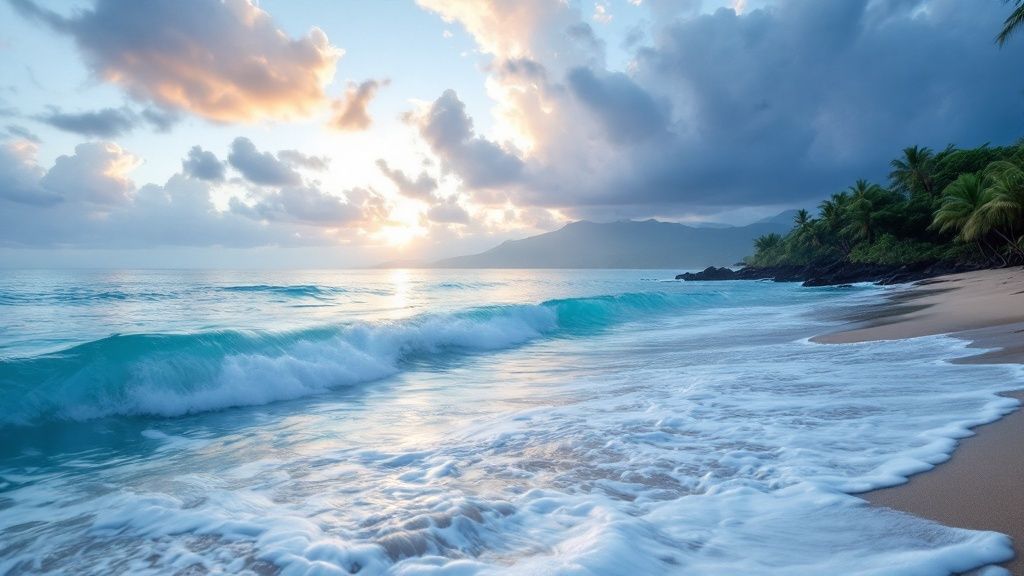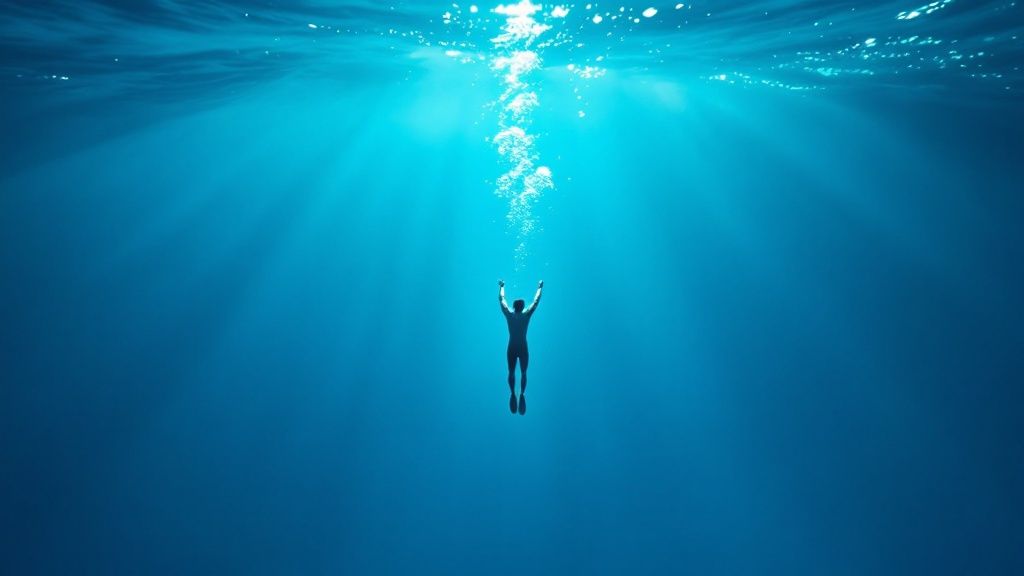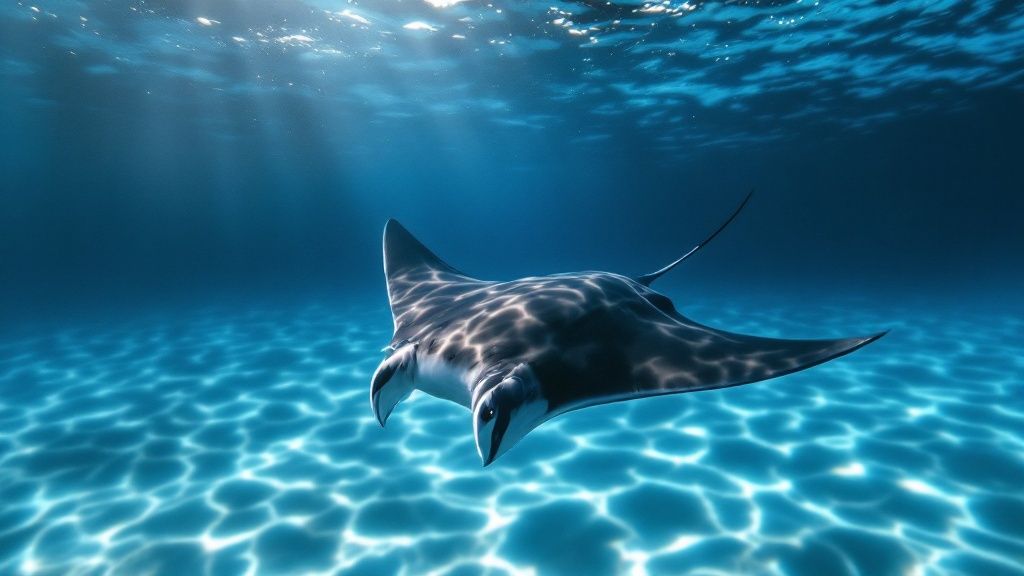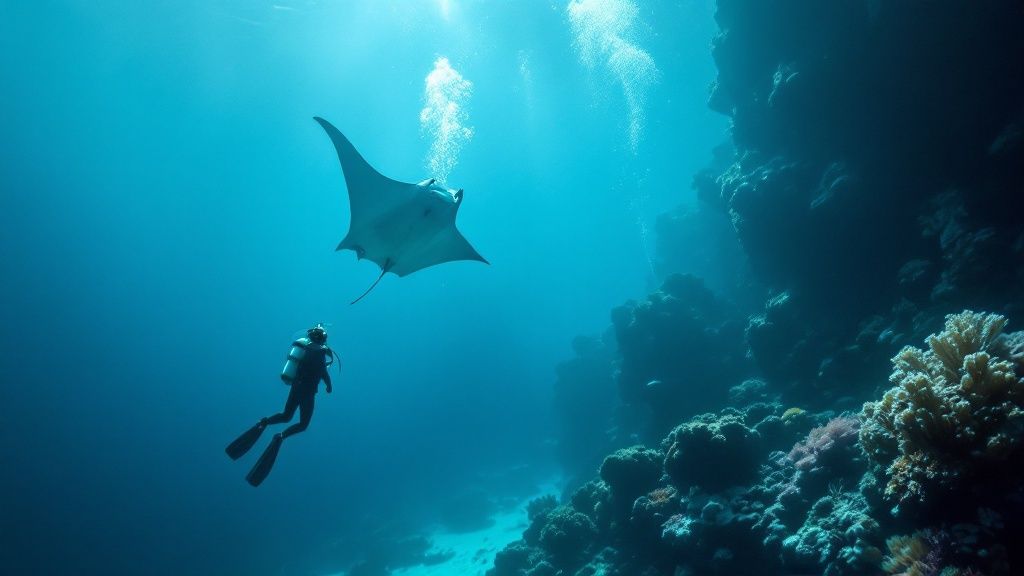Swim with Manta Rays Hawaii: Mesmerizing Night Adventure
- Byron
- 4 days ago
- 11 min read
The Magic of Swimming With Manta Rays in Hawaii

Picture this: you're floating in the dark Pacific Ocean, millions of stars above. Suddenly, a shape emerges from the deep. Growing larger and larger, it becomes a graceful manta ray. This is the magic of a Hawaiian manta ray encounter, an experience impacting over 80% of those who try it.
This incredible adventure, especially off the Kona Coast, attracts approximately 80,000 people each year. They come to watch these gentle giants feed on plankton, illuminated by underwater lights. For more interesting manta ray facts, check out this article: 10 Things You May Not Know About Manta Rays in Hawai‘i
Why the Kona Coast?
The Kona Coast has become a prime location for manta ray encounters. The unique underwater landscape, combined with nutrient-rich waters, creates an ideal environment for plankton. This is the manta ray's primary food source, and its abundance attracts large numbers of these magnificent creatures, making sightings almost a guarantee.
Many responsible tour operators prioritize sustainable practices. They strive to minimize their environmental impact while ensuring a high-quality experience.
A Sensory Journey
Swimming with manta rays in Hawaii is a truly immersive experience. The initial anticipation as you enter the dark water quickly shifts to wonder as these majestic animals appear in the light. The sensation of floating weightlessly as they glide beneath you is both humbling and thrilling.
Their graceful movements, often compared to an underwater ballet, leave a lasting impression.
The Hawaiian Magic
The experience is enhanced by a special Hawaiian touch. The combination of moonlight, warm Pacific waters, and the traditional Hawaiian reverence for marine life creates a powerful connection with nature. Learn more about this special experience: Manta Ray Night Snorkel Blog Posts
Some tours even weave in elements of Hawaiian culture and storytelling, further enriching the encounter. Whether you choose Kona Honu Divers, Manta Ray Night Snorkel Hawaii, Kona Snorkel Trips, or Captain Cook Snorkeling Tours, this experience is sure to stay with you. The unique blend of nature, adventure, and culture is what makes swimming with manta rays in Hawaii an unforgettable journey.
Prime Kona Locations for Unforgettable Manta Encounters

The Kona Coast of Hawaii isn't just a beautiful destination; it's a world-renowned haven for manta rays. Choosing the right spot can dramatically improve your chances of a truly memorable encounter. Let's explore some of Kona's best locations.
Manta Village (Keauhou Bay)
Keauhou Bay, often called Manta Village, is famous for its consistent manta ray sightings. The bay's shallow, calm waters create a perfect environment for plankton, the manta rays' primary food source. This predictable food supply makes Manta Village a reliable spot for an unforgettable encounter.
Manta Heaven (Garden Eel Cove)
North of Kona International Airport lies Manta Heaven, also known as Garden Eel Cove. The gentle slopes and sandy bottom of this cove offer a beautiful backdrop for observing these graceful creatures. The clear waters often provide excellent visibility, making for a truly immersive experience.
Tracking Manta Ray Movements
Manta rays in Hawaii often travel significant distances. In 2020, one tagged manta, Loulou Ray, swam an incredible 42 miles from the Kohala Coast to Keauhou in just eight weeks. To learn more about these fascinating migratory patterns, check out the Manta Ray Movement Patterns resource.
The following table summarizes the top manta ray viewing locations in Kona:
Top Manta Ray Viewing Locations in Kona
Comparison of the main locations for manta ray encounters in Hawaii, including success rates, accessibility, and unique features
Location | Success Rate | Best Time | Access Method | Special Features |
|---|---|---|---|---|
Manta Village | High | Evening | Boat tours | Calm, shallow waters |
Manta Heaven | High | Evening | Boat tours | Clear waters, sandy bottom |
Other Kona locations | Varies | Evening | Boat tours, Snorkel | Intimate experiences |
This table provides a quick overview of the primary viewing locations and their key characteristics. It helps illustrate the differences in accessibility and what each location offers in terms of viewing experience.
Exploring Beyond the Popular Spots
While Manta Village and Manta Heaven are popular choices, exploring lesser-known spots can offer a more intimate encounter with fewer crowds. These locations are often accessible through smaller tour groups, allowing for a more personalized experience. For those interested in these hidden gems, Our Sitemap provides more detailed information.
Choosing Your Ideal Manta Ray Experience
The ideal location depends on your individual preferences. Manta Village is excellent for reliable sightings and easy access. For the more adventurous, exploring less-traveled areas might be more appealing. Consider factors like water conditions, visibility, and accessibility when making your choice.
Optimal Viewing Times and Planning Your Trip
The best time to witness these gentle giants is during the evening hours. As the sun sets, plankton rise to the surface, attracting the manta rays who feed on these microscopic organisms. Most tours offer nighttime excursions to maximize your chances of a spectacular encounter.
When planning your trip, consider group size and tour operator experience. These factors can significantly impact your overall experience. Choosing a reputable operator like Manta Ray Night Snorkel can ensure a safe and memorable adventure. While Kona is renowned for manta rays, the Florida Keys are a popular destination for snorkeling. You might also be interested in learning about snorkeling in the Keys. With a little planning, you're sure to have an unforgettable experience.
Selecting Your Perfect Manta Ray Tour Experience

Swimming with manta rays in Hawaii is an experience you'll never forget. But choosing the right tour operator can make all the difference. It's not just about checking something off your list; it's about creating a truly special memory. This requires looking beyond the basic tour descriptions and considering some key factors.
Key Considerations When Booking a Tour
A truly great manta ray experience relies on several things. Group size, for example, can have a big impact. Smaller groups often mean more individual attention from the guides and less disruption to the manta rays' natural behavior.
Another important aspect is the operator's experience and dedication to sustainable tourism. Look for certifications or memberships in respected organizations. These demonstrate a commitment to responsible environmental practices.
Here are some additional factors to consider:
Vessel Type: Think about the boat's stability and comfort, especially if you're prone to seasickness. Some tours offer smaller, more intimate boats, while others use larger, more stable catamarans.
Guide Knowledge: Guides who really understand manta ray behavior can make your experience richer. They can offer valuable information about their feeding habits, how they interact with each other, and even individual manta ray personalities.
Booking Details: Don't forget to check cancellation policies, photography options, and whether the tour is suitable for different swimming abilities and ages.
Spotlight on Kona's Top Manta Ray Tour Operators
Kona offers a fantastic selection of manta ray tours. To help narrow it down, we've highlighted four exceptional operators:
[Kona Honu Divers](https://konahonudivers.com/snorkeling-tours/manta-ray-snorkel/): Known for small groups and personalized attention.
[Manta Ray Night Snorkel Hawaii](https://www.mantaraynightsnorkelhawaii.com/): Offers two nightly tours, giving you more scheduling flexibility and a potential sunset view.
[Kona Snorkel Trips](https://konasnorkeltrips.com/snorkel-tours/manta-ray-snorkel-kona/): Focuses on education and safety, with lifeguard-certified guides leading every tour.
[Captain Cook Snorkeling Tours](https://www.captaincooksnorkelingtours.com/): Offers a range of snorkeling trips in Kona, catering to various interests and skill levels.
These operators offer various tour options, including intimate small group tours and private charters. For more in-depth information, check out the Manta Ray Night Snorkel Hawaii blog posts.
To help you compare these options, we've compiled the following table:
Manta Ray Tour Operator Comparison: Detailed comparison of top manta ray tour operators in Kona, Hawaii, including prices, group sizes, equipment provided, and special features.
Tour Operator | Price Range | Group Size | Duration | Equipment | Special Features | Customer Rating |
|---|---|---|---|---|---|---|
Kona Honu Divers | $150-$200 | 6-12 | 2-3 hours | Snorkel gear, wetsuits | Small groups, personalized service | 4.9 stars |
Manta Ray Night Snorkel Hawaii | $125-$175 | 12-24 | 2-3 hours | Snorkel gear, flotation devices | Two nightly departures, sunset views | 4.7 stars |
Kona Snorkel Trips | $140-$190 | 10-20 | 2.5-3.5 hours | Snorkel gear, wetsuits, life vests | Lifeguard-certified guides, educational focus | 4.8 stars |
Captain Cook Snorkeling Tours | $130-$180 | 15-30 | 2-3 hours | Snorkel gear, flotation devices | Variety of tour options, experienced guides | 4.6 stars |
Note: Prices and other details may vary. Please check with the individual tour operators for the most up-to-date information.
As you can see, each tour operator offers unique advantages. Choosing the right one depends on your preferences and priorities, such as group size and special features.
Ensuring a Safe and Memorable Experience
Safety and comfort are essential. Reputable operators will provide thorough instructions before you enter the water. These briefings cover everything from equipment use to respecting the manta rays’ space. They’ll also provide wetsuits or flotation devices to keep you comfortable in the cooler evening waters.
Remember, these are wild animals in their natural habitat. Keeping a respectful distance, avoiding sudden movements, and not touching the manta rays are crucial for both your safety and theirs.
By considering these tips and choosing a responsible tour operator, you'll have a much better chance of an incredible manta ray experience in Hawaii. You’ll leave with not just amazing memories, but also a deeper understanding of these magnificent creatures and why it’s so important to protect them.
Understanding Hawaiian Manta Ray Behavior

Swimming with manta rays in Hawaii is a truly magical experience. It's not just about the visual spectacle; it’s about connecting with these fascinating creatures and understanding their intricate behaviors. This deeper understanding transforms a simple swim into a powerful and memorable encounter with the marine world.
Decoding the Barrel Roll
One of the most captivating manta ray behaviors you'll witness during a night swim is the barrel roll. This feeding technique involves the manta spiraling through the water, mouth agape, to efficiently consume plankton. Imagine witnessing this mesmerizing display firsthand!
It's a testament to how perfectly adapted mantas are to their environment. Their cephalic fins expertly funnel plankton-rich water into their mouths, making them incredibly effective filter feeders.
The Unique Fingerprint of Each Manta
Did you know each manta ray possesses a unique belly pattern, much like a human fingerprint? This pattern allows researchers and guides to identify individual mantas, providing valuable insights into their movement patterns and habits.
This unique identification also allows repeat visitors to recognize "regular" mantas, adding a personal touch to the experience. You might even begin to recognize individual personalities! Interested in learning more about manta rays? Check out this Blog Categories Sitemap.
Intelligence and Social Dynamics
Manta rays are remarkably intelligent creatures, possessing the largest brains of any fish. Their size is equally impressive. Giant manta rays can have wingspans up to 25 feet and weigh as much as 3,000 pounds, while newborns have wingspans of approximately six feet.
They've even demonstrated self-awareness in mirror tests, a cognitive ability shared by great apes and dolphins. This intelligence, combined with their impressive size, makes swimming with them an unforgettable experience. Learn more about these fascinating creatures. Observing their social dynamics at feeding sites adds another layer of fascination to the whole encounter.
Navigating Their World
Mantas navigate the vast ocean with remarkable precision, using a combination of visual cues, magnetic fields, and even their sense of smell. Understanding their navigation abilities highlights the interconnectedness of marine life and their environment.
Learning about these complex behaviors fosters a deeper appreciation for the importance of manta ray conservation. By choosing responsible tour operators like Kona Honu Divers, Manta Ray Night Snorkel Hawaii, Kona Snorkel Trips, or Captain Cook Snorkeling Tours, you contribute directly to the protection of these incredible animals.
Preparing For Your Manta Ray Night Swim Adventure
Getting ready for your manta ray night swim in Hawaii? After selecting your tour and brushing up on manta ray behavior, it’s time to focus on the practicalities. This guide will help you prepare for this incredible experience.
What To Expect On Your Manta Ray Night Swim
Knowing the general flow of the evening can ease any pre-trip jitters. Most tours begin with a check-in and gear distribution, including wetsuits. A short boat ride then takes you to the manta ray viewing site. Guides will provide a briefing on manta ray interaction and equipment usage, including flotation devices.
The actual in-water time is typically 20-30 minutes. This provides ample opportunity to observe the mantas' feeding habits and graceful movements. Remember, even Hawaiian waters can be cool at night. Most tours return to the dock for post-swim drying and changing.
Essential Gear and Comfort Tips
Proper packing is key for a comfortable and enjoyable night swim. While your tour operator will likely provide snorkel gear and wetsuits, bringing your own ensures a personalized fit.
Wetsuit or Layers: Ocean temperatures drop at night. A wetsuit is highly recommended. If you prefer not to wear one, dress in layers to adjust to temperature changes.
Towel and Dry Clothes: Essential after your swim. A quick-drying towel is especially useful.
Seasickness Remedies: Prone to seasickness? Take precautions. Over-the-counter medication or acupressure wristbands can help.
Capturing Your Manta Ray Encounter
While capturing this experience is tempting, prioritize enjoying the moment. If you bring a camera, ensure it's waterproof and securely attached to a float or wrist strap.
GoPros are a popular choice for underwater photography. If your tour includes a photographer, consider using their services for high-quality images without the distraction of managing your own camera.
Tips For Non-Swimmers and Those With Water Anxiety
Even if you’re not a strong swimmer, you can still participate. Many tours offer flotation devices like pool noodles, allowing you to float effortlessly while observing the manta rays.
Communicate any concerns to your guides. They're experienced in assisting participants of all swimming abilities and can offer support. Remember, viewing from the boat is also a magical experience.
Pre-Swim Checklist: Preparing For Your Adventure
A little planning ensures a smooth and enjoyable manta ray swim. Here's a handy checklist:
Confirm Booking: Double-check the date and time, especially during busy periods.
Plan Transportation: Arrange your travel to the tour meeting point.
Charge Devices: A fully charged phone is essential for communication and photos.
Pack Snacks and Water: Stay energized with light snacks and plenty of water.
Review Tour Details: Familiarize yourself with the itinerary and any specific instructions.
Contact Tour Operator: Reach out with any questions or special needs.
Reputable operators like Kona Honu Divers, Manta Ray Night Snorkel Hawaii, Kona Snorkel Trips, or Captain Cook Snorkeling Tours contribute to a safe and enriching experience, leaving you with lasting memories of your manta ray adventure. Following these guidelines ensures you’re well-prepared to experience the magic of swimming with manta rays in Hawaii.
Swimming With Mantas: Conservation and Legacy
Swimming with manta rays in Hawaii offers a unique opportunity to contribute to the preservation of these incredible animals. It's more than just a personal thrill; it's a chance to participate in a vital conservation effort. This section explores the connection between responsible tourism and the future of Hawaiian manta ray populations.
Responsible Tourism: A Powerful Force for Protection
Responsible tourism plays a significant role in protecting Hawaiian manta rays. Ethical tour operators actively contribute to conservation through sustainable practices. These practices minimize disturbance to the mantas' natural environment and adhere to strict interaction guidelines.
Tour operators often limit group sizes and enforce no-touch policies. They also educate visitors about manta ray biology and behavior. This approach preserves the mantas' habitat and ensures their long-term survival while providing an unforgettable tourist experience. It's a win-win for both the mantas and the visitors.
Evolution of Interaction Guidelines
Over time, the guidelines for swimming with manta rays have changed significantly. Driven by research and a growing understanding of manta ray behavior, these changes prioritize the animals' well-being. Early interactions may have been less structured, potentially causing stress to the mantas.
Today's guidelines, developed with marine conservationists and responsible tour operators, minimize disruption to the mantas' natural behavior. This fosters a deeper appreciation for these gentle giants and the importance of their conservation. It also allows for a more enriching experience for visitors.
Identifying Genuine Sustainability
It’s important to distinguish genuine sustainability practices from marketing claims. Look for tour operators like Kona Honu Divers, Manta Ray Night Snorkel Hawaii, Kona Snorkel Trips, and Captain Cook Snorkeling Tours that actively participate in research initiatives, contribute to conservation funds, and promote educational programs.
Checking for membership in relevant conservation organizations is also helpful. Consider checking out Manta Ray Night Snorkel Hawaii Blog Posts for more information. These actions demonstrate a true commitment to responsible tourism. Choosing these operators ensures your experience directly benefits the manta rays and their environment.
Challenges and Success Stories
Despite conservation progress, Hawaiian manta ray populations face ongoing challenges. Fishing pressures and the impacts of climate change pose significant threats. However, there are inspiring success stories highlighting tourism’s positive impact.
In some areas, tourism revenue directly funds manta ray research and protection initiatives. This includes crucial work like tagging and tracking to understand movement patterns and habitat use. These initiatives, difficult to fund otherwise, demonstrate the power of responsible tourism in marine conservation.
Extending Your Impact Beyond Your Swim
Your contribution to manta ray conservation can continue long after your tour. You can participate in citizen science projects, submitting photographs of manta ray belly patterns for identification to aid researchers. Supporting advocacy efforts to protect manta ray habitats and reduce fishing pressures also makes a difference.
These actions contribute to the long-term health of manta ray populations, ensuring future generations can experience the wonder of swimming with these graceful creatures. By getting involved, you become part of a larger movement to protect our oceans.
Experience the magic of swimming with manta rays and contribute to their conservation. Book your tour today with Manta Ray Night Snorkel Kona Hawaii Tours and be a part of this incredible legacy.
Comentarios